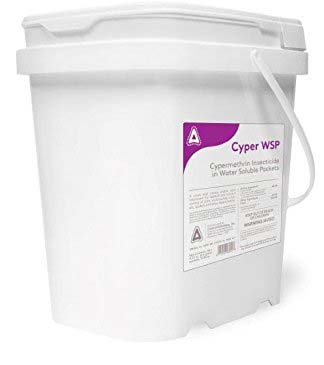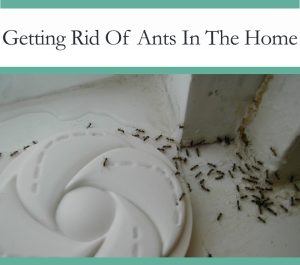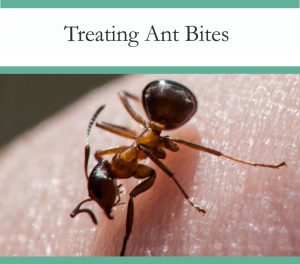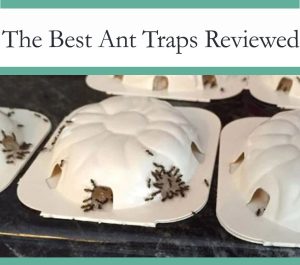Pavement Ants
Pavement Ants – What they look like, how you get them & how to get rid of them.
Tetramorium Caespitum
Facts, Identification & Control
Pavement Ants, sometimes called Sugars Ants, or grease ants are small black-brown ants (1/8–1/16-inch long) prevalent in some parts of North America. Colonies of these, build their nests under pavements, hence their common name. They are one of the most commonly seen ants in this part of the world and they have adapted to urban and suburban habitats well. They have one pair of spines on their back, two nodes on their petiole (narrow waist) and they have grooves on the head and their thorax (middle body).
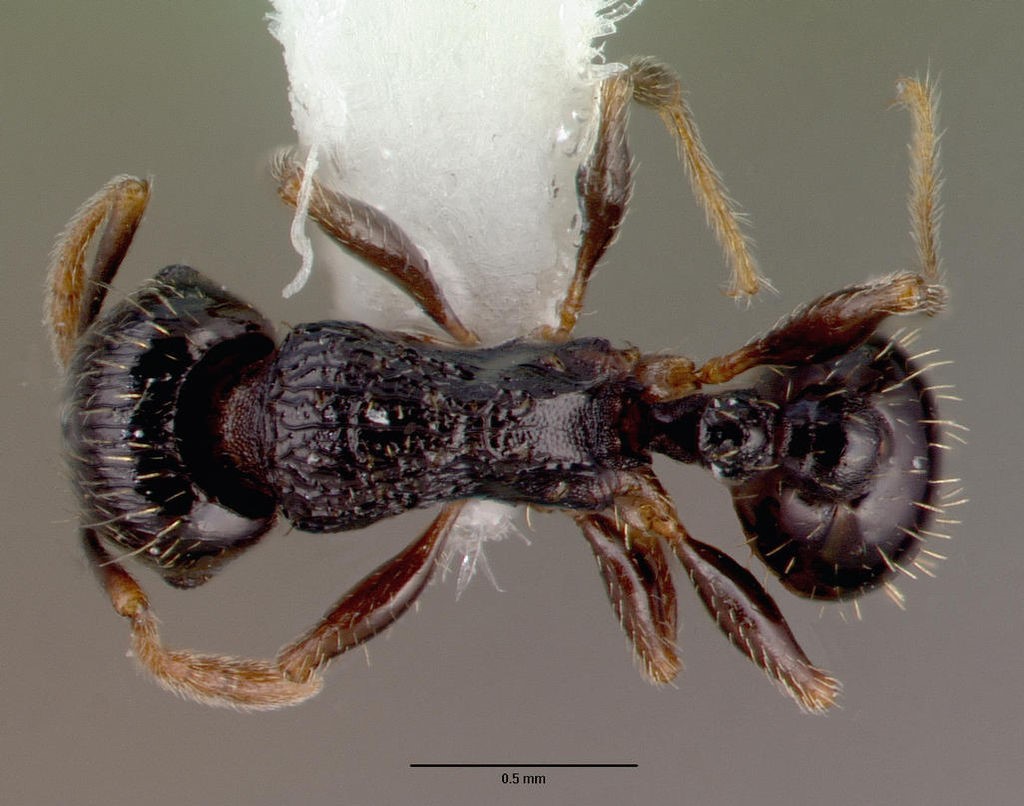
Tetramorium Caespitum 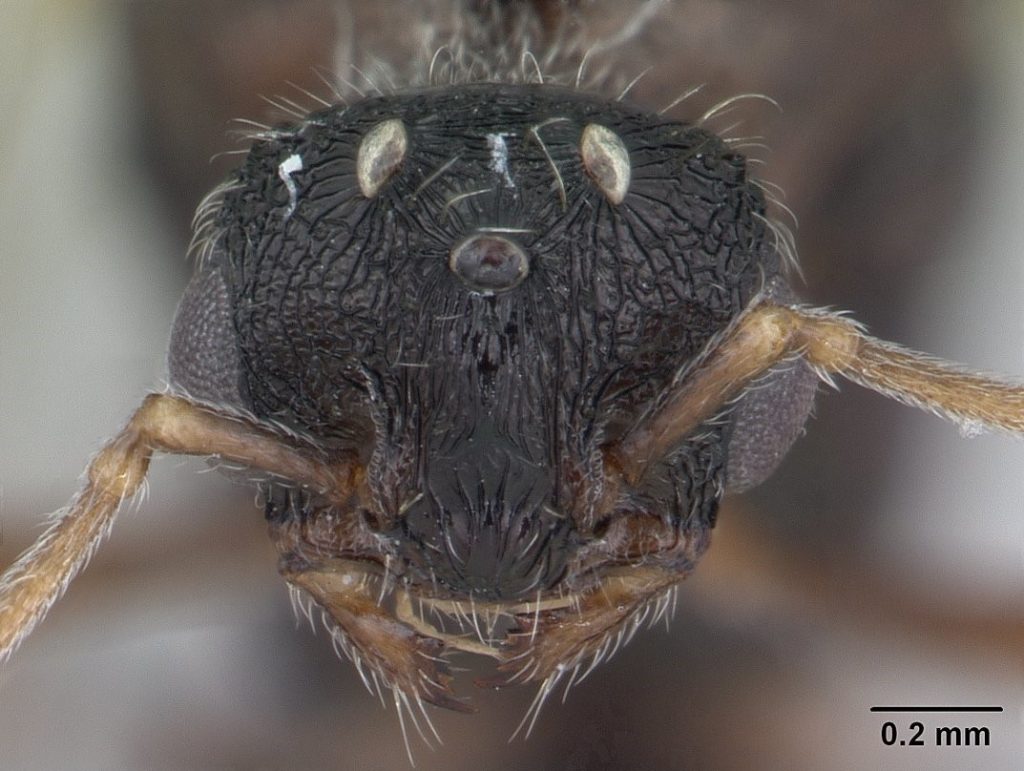
Face View closeup of the pavement ant

Identification & Characteristics
- Other Names: Sugar Ants
- Odor: They give off a smell of banana oil to deter predators
- Color: Dark brown to black
- Size: Workers are about 2.5 to 4mm long, while the queen is up to 8mm long
- Legs: Six
- Antennae: Yes. They have 12 segmented antennae, with a three-segmented club
- Shape: Oblong shaped thorax with grooves, has one pair of spines on the back and two nodes on its small waist

Habitat
Pavement Ants have adapted well to urban areas and are usually build their nests underground where there is little vegetation such as:
- Sidewalks
- Driveways
- Patios
- Crevices on walls of buildings
Their nests are about 13 to 52 square feet and 18 to 35 inches deep. Colonies may have up to 3,000 to over 10,000 ant workers. Pavement ants have polygene colonies, where there is more than one queen. You can identify them when you see entrance holes surrounded by small crater-shaped mounds of sand during warm seasons. They can protect a territory of about 450 square feet.
Pavement Ants are found mostly in the eastern and southern states of North America.

Behavior
Pavement Ants are known for their aggressive behavior toward nest intruders. They can often be found in a fight with other ants or even entire colonies and will fight to injury or death. They are active during the day foraging for food and bringing it back to the nest. They also use chemical signals to communicate with one another. When searching for food, the worker ants will leave a chemical trail by wiping their gasters on the ground as they walk.
Pavement Ants will eat anything, including:
- Other insects
- Seeds
- Honeydew
- Bread
- Meats
- Nuts
- Cheese
Pavement Ants are also drawn toward sugary food like sweets and Ice cream. They store seeds and grains in their nest for later use. They also drink nectar produced by the lycaenid caterpillar.

Reproduction
Virgin queens and male ants fly into the air to mate; known as their nuptial flight. This nuptial flight occurs in spring or summer where queens and drones leave the nest and a find a mate. After mating, they both lose their wings and the young queens set out to start their nests while the male ants die. The queen stores all the sperm from the mating, enough from one flight, so that she can fertilize eggs for the rest of her life.
The queen must raise the first generation of young by herself until they are old enough to gather food. During this time, she survives by using up the proteins of her flight muscles. It takes two to three months from the time that the eggs hatch and develop, and they spend that time tending to the queen.
Pavement Ant colonies can grow very quickly and large since there are more than one egg layer. One queen will lay anywhere from five to up to forty eggs per day. Fertilized eggs become workers or other queens, and unfertilized eggs either develop into male ants or are eaten by the colony.

Are Pavement Ants Dangerous?
Pavement Ants excavate huge amounts of soil and sand from under roads, building foundations and walkways. Through the passage of time, this kind of activity can result to sinking and settling of the soil leading to structural damage of the above surface. However, the most common complaint is infestation at people’s homes where the ants are foraging for food which is of no real danger.
It is worth noting that worker Pavement Ants do have a small stinger, which can cause discomfort in humans and lead to skin irritation.

Signs of a Pavement Ant Infestation
Most common signs indoors, is seeing these ants on your counter tops, kitchen, pantry, cupboards, kitchen cabinets and anywhere food is kept. Outdoors, you will see a lot of them in pavements, building foundations, wall cracks or crevices. You would notice piles of soil or sand around the area where they are taking refuge as this is the material they have excavated from their nest.

Controlling Pavement Ants
Spraying driveways, walkways or crevices directly is rarely effective since this only kills the workers on the surface. Given the large quantity of workers in one colony, they will just send more of them to continue foraging for food. An effective way to get rid of pavement ants indoors is by setting up bait stations along the observed ant trail. This will attract workers and carry it back to the nest where the queen will feed on it. This will help kill both the queen and its eggs.
You can try chemical ant baits like Terro Ant Killer II which is specifically designed to deliver fast-acting elimination of the ants that you see and those that you don’t. These types of products are specifically formulated to allow ants to consume the product and survive long enough to bring them back to the nest and deliver a dose to the rest of the colony. Make sure that you leave the product undisturbed while the ants are feeding on it and eliminate all other food sources that may divide their attention or distract them from only going to your bait as the food source. Indoor colonies may also be treated with residual dust pesticides like Delta Dust Insecticide. Dust inside crevices or wall cracks and underneath base boards.
You can also make your own bait, by mixing household borax with honey or syrup.
Outdoor Control
For control outdoors, you must trace the ant trail back to their below-ground nest and drench it with insecticide spray.
Drenching means applying enough of the liquid insecticide to drown all the ants in the nest and the surrounding area. Make sure to read the product label for specific directions. Pets and children should be kept away from the treated area for a few hours. You can try Cyper WP which is available in 1lb containers.

Best Products to Get Rid of Pavement Ants
Inside the House:
Baiting Pavement Ants is the most effective way one of getting rid of them, since it will also kill those that are not visible to you. Mix the baits with protein based or sugar-based food to attract and kill them and the rest of their colony and even their queen.
Recommended Bait Types:
Best Products for Outside the House:
For outdoor spraying, make sure to spray a good barrier around the home. And make sure to apply enough insecticide to soak the nest and to drown the ants using a gallon sprayer.
Consider Seeking Professional Help
Homeowners can find it challenging to find and treat the ant colony, as it requires time and patience. Ant colonies need to be traced and they are sometimes tricky to find. You have the option to call an exterminator to help you find the ant colony. They have effective and professional tools and other resources to end the infestation in your area. Dial (866) 250-4176 for a free exterminator quote!

Preventing Pavement Ant Infestations
After applying the appropriate chemicals, these steps will help maintain control and prevent re-infestation:
- Observe and practice sanitation. Clean up and move things around from time to time to limit the possible areas where the ants can hide.
- Keep food preparation stations to specific areas. Limit the number of areas in your home where you prepare snacks or meals and where family members eat. Make sure to clean the area thoroughly after meal preparations and after eating.
- Cover up cracks and gaps. Cracks or small spaces on the wall, flooring, foundations, baseboard, window frames and door frames can serve as entry points for ants, so it is highly recommended that you fill them with caulk or similar to block off any possible entry points.
- Remove stacked or piled materials around your house. Keep away piles of lumber, stones, bricks, heavy mulch or other debris around your home. These serve as potential ant harborage, so it’s best to keep them in a place far from the house.
- Trim branches of trees and shrubs. Cut or trim tree branches and other vegetation around your house that touches the structure, as these can serve as ant highways and gives them access in and out of your home, bringing the food back to their colonies.





